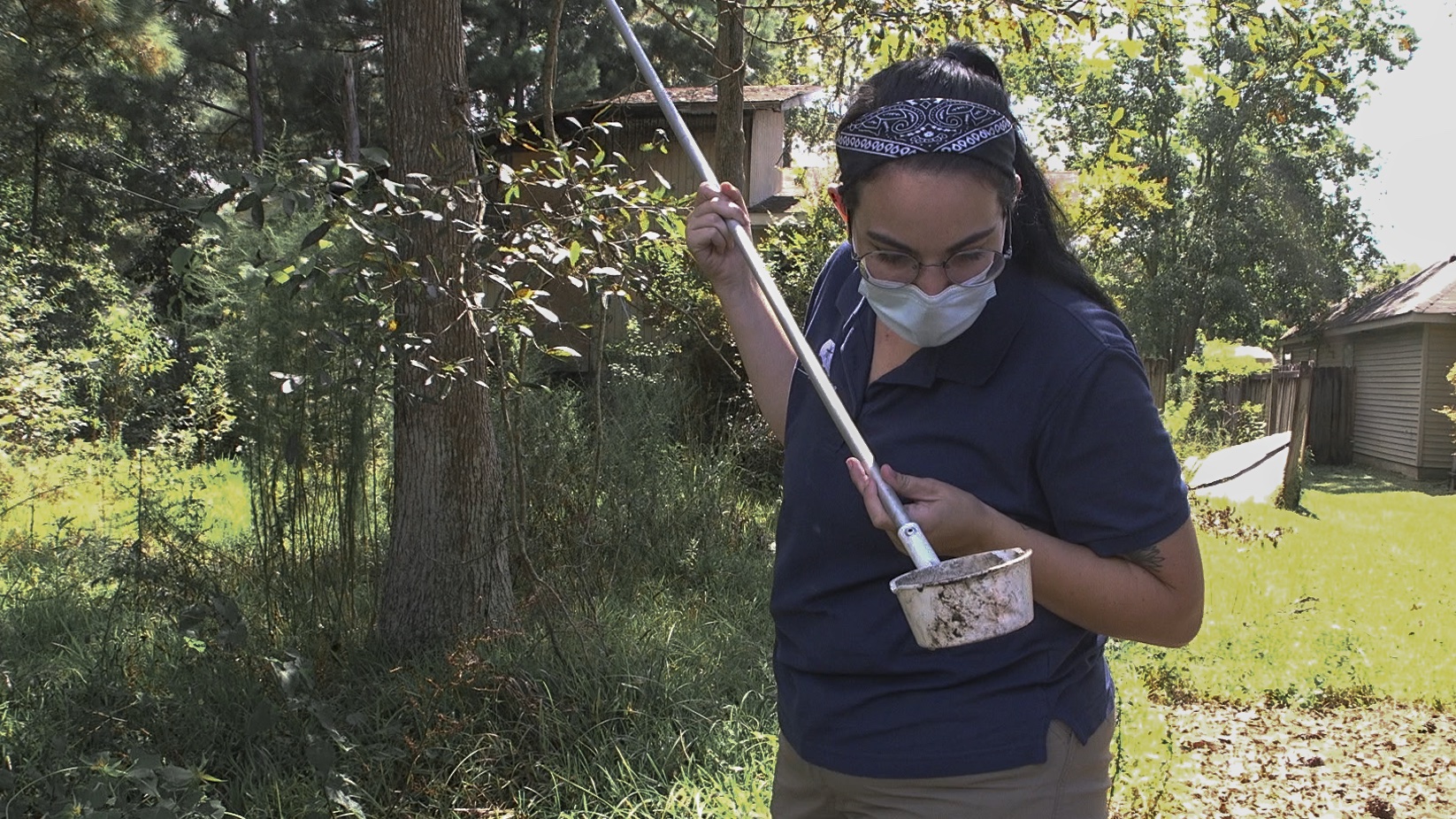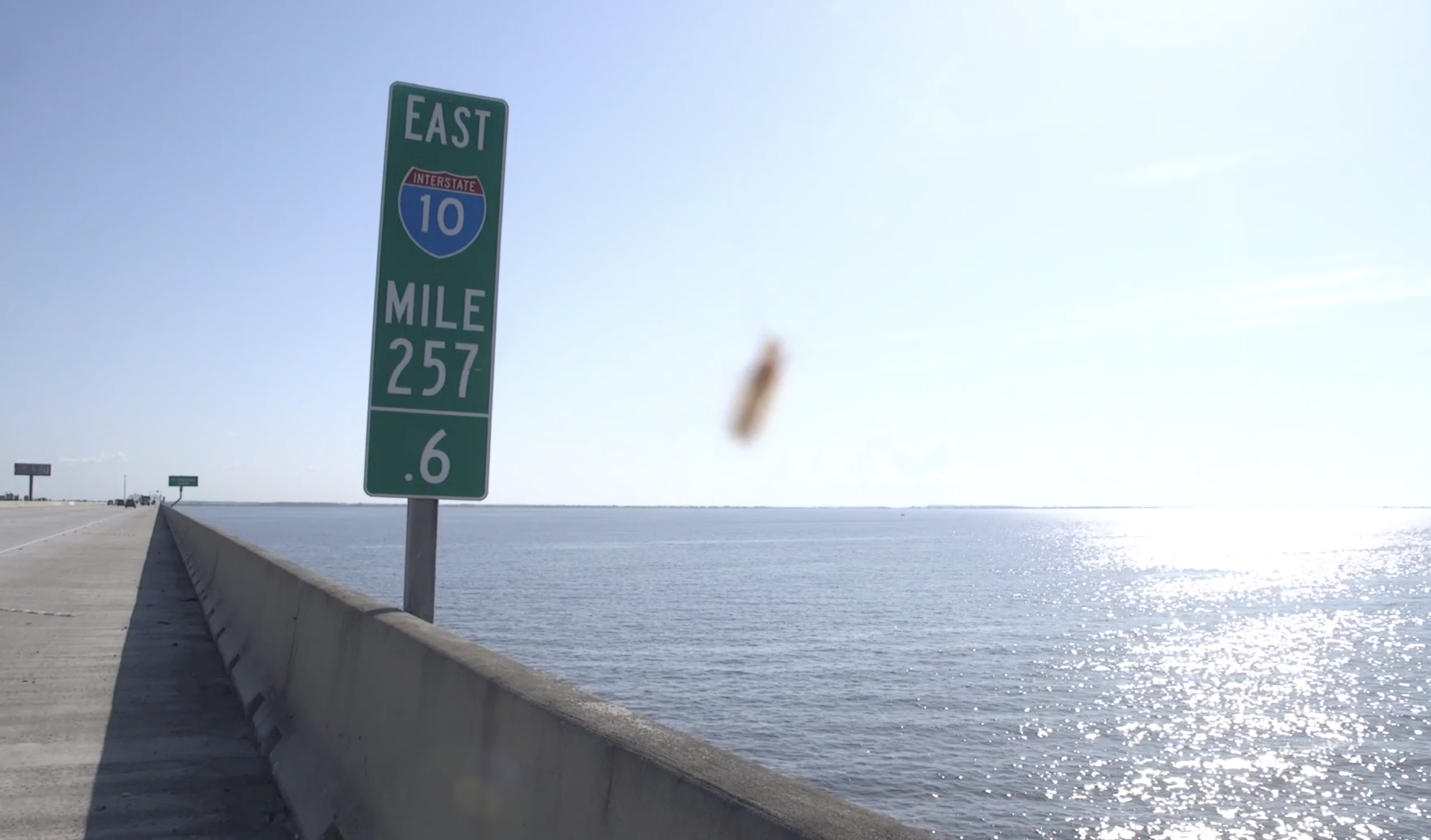
Sydney Johnson’s boots clomp and groan as she hops from her white truck and trudges across a cul-de-sac in Lacombe, Louisiana. Children’s toys and debris are strewn about the yards in St. Tammany Parish. It’s a hot day, and Johnson’s black hair is tied up in a black bandana. Sweat beads on the tattoos that peek out from under her polo. She passes wilting grass and tilted mailboxes to a water-filled ditch between two driveways. The water wiggles as she approaches and frogs jump from the muddy banks.
Just about anything in Louisiana, it seems, can kill you—from hurricanes to alligators to bad oysters—but today Johnson is hunting the most deadly animal in the world.
The world’s largest killer is actually quite small—so small you don’t even notice they’ve bitten until after you are itching the welt. More than just a pest, mosquitoes carry viruses such as Zika, West Nile, Chikungunya, and dengue, as well as the parasite that causes malaria. Worldwide, these mosquito-borne diseases cause around 750,000 deaths per year. In 2020, malaria was responsible for 627,000 deaths worldwide. That’s why Johnson, a St. Tammany Parish Mosquito Abatement biologist, is on the hunt.
In the U.S, mosquito-borne diseases have increased since 2004. West Nile virus is the most common mosquito-borne disease, killing 66 Americans and infecting more than 731 people in 2020 alone. While the number of people infected by the virus has decreased since 2002 when it was discovered in the U.S., the infections and deaths have vacillated greatly. There was a 700 percent increase in infections from 2011 to 2012. The following year, the infections dropped by more than half. In 2021, preliminary CDC data show one of the biggest infection rates of the last decade.
As climate change makes the southern U.S. more hospitable to mosquitoes, new diseases are expected to crop up. A buffet of treatments and abatement strategies are used locally in the U.S., ranging from bacteria to natural predators. Which areas have access to those treatments, however, depends on their financial and logistical capacity to implement an integrated mosquito management program, said abatement specialists.
Here in Louisiana, West Nile virus cases surged after Hurricane Katrina besieged the area in late August 2005. Twelve cases appeared in Orleans Parish in 2006, double the number of cases the year before. West Nile dropped back to two cases per year in 2007 and 2008, with another surge to 11 cases in 2012. No new human cases had been reported since then—until this year.
The primary spreader of West Nile and the main target of abatement across Louisiana is Culex quinquefasciatus, the southern house mosquito.
“A lot of people think of mosquitoes like dogs,” said Janet McAllister, a medical entomologist at the Centers for Disease Control and Prevention (CDC). “A Chihuahua and a Great Dane are very different, but they're all dogs. They all act the same and have similar behaviors.”
It turns out, however, that dogs are not the right analogy. “Mosquitoes are like birds, actually, not dogs,” she said. “Like a hummingbird and a bald eagle. They eat different things that live in different places. They rear their young differently. And they are truly different species, not different breeds of one species. And people get confused because to them, a mosquito is a little tiny bug. But to trained entomologists, they are very different.”
Because of these differences among species, which vary in prevalence from parish to parish based on their natural habitats, combating mosquitoes requires an integrated plan with various approaches.
To learn more about the approaches, let’s rejoin Johnson on this sweltering day in August, while she visits one of the hot spots on her weekly route—a small neighborhood rife with ponds and puddles teeming with mosquito larvae. Joining her is Jennifer Bushnell, the media director for the parish.
“The milky color is a really large indicator that you're gonna find mosquitoes in the area,” says Johnson, gesturing to a septic ditch. “There’s a bunch in the muck that are hiding and eating that disgustingness.”
She dips a shallow cup on a four-foot pole into the grass edge of the milky muck and holds the scoop to her face. The silt settles in the cup and she points to little black bits of debris floating in the foul water of the ladle, each half the size of a sesame seed. These are mosquito eggs. Each honey-combed egg “raft” can birth hundreds of mosquitoes.
“You can put your dipper in there and see mosquitoes and all kinds of goodies,” she says, tilting the cup to avoid the glare of the sun. Referring to the clusters of mosquito eggs, she adds, “Oh my gosh, look how many rafts I got!”
Bushnell counts six. “That's like a thousand mosquitoes minimum that are gonna hatch in a day or so,” says Bushnell.
“This is a ditch I check every single week because I know this is hot with mosquito infestation," says Johnson.
“And then you can see all of those—bloop bloop—the little itty bitty ones,” she points to squirming, almost translucent critters wriggling to the surface. “Those are all little mosquitoes, pressing up against the surface.”
In a few days, these mosquito larvae and pupae could all be adults. Though most will only stay within a mile of where they were born, some species are capable of flying 20 to 40 miles in less than a week and could be buzzing by ears, biting residents, and passing along diseases, such as West Nile virus.
There are no vaccines for West Nile virus, the leading cause of mosquito-borne illness in the U.S., according to the CDC. While over-the-counter pain relievers can be administered to relieve some symptoms—which range from headache and vomiting to paralysis and coma—no treatment exists for the underlying infection. Eight out of 10 people who are infected with West Nile virus do not feel sick. However, approximately one out of 150 infected people develops a serious, and sometimes fatal, illness.
According to the CDC, even mild cases can have residual symptoms, such as fatigue and weakness, that can last for weeks or months. Recovery from a severe infection also might take several weeks or months and some effects to the central nervous system might be permanent. About one out of 10 people with the severe illness will die.
After Johnson pours the turbid liquid, larvae and all, onto the searing blacktop road to desiccate in the summer sun—the simplest method of mosquito control—she goes back to her truck. It’s treatment time.
A natural solution
Researchers are developing numerous novel and advanced approaches for preventing mosquito-borne illnesses. For instance, biologists using CRISPR-Cas9 gene-editing technology have identified mutations that make it harder for mosquitoes to sense humans. In another experiment, female mosquitoes infected with bacteria reduced human dengue infections. And sexy-sounding (to mosquitoes, anyway) traps lure the insects to a zap trap. But for most mosquito control operations throughout the U.S., these advanced approaches are not available or may not be feasible.
“It's only going to be another tool,” said McAllister, the CDC entomologist.
“I don't actually see some of these new technologies really bringing a lot extra to the table,” added McAllister. “Right now, they are super expensive… Mosquito control districts don't have the extra money. I don't necessarily see New Orleans or Lake Charles or places in Louisiana having those resources.”
In any case, only one mosquito species has been successfully genetically modified in the U.S., according to McAllister. While this species, Aedes aegypti, can carry and spread dengue fever, chikungunya, and Zika fever, it lives only in subtropical areas like the southernmost part of the Florida peninsula. It does not spread West Nile virus, the main mosquito-borne illness affecting Louisiana.
“It's not our most important vector species. In fact, it's not even in the same genus as our most important vector species,” said McAllister, referring to the capacity of Culex quinquefasciatus, the southern house mosquito, to transmit infections such as West Nile.
Meet the minnows
The most sustainable and cost-effective method for mosquito control has been in use for more than 70 years, according to the Louisiana Mosquito Control Association training manual.
Tucked away in a trickling, makeshift pond, hidden in the corner of a corrugated metal garage with St. Tammany’s fleet of white spray trucks is this mosquito combatant: a species of topminnow, Gambusia affinis, a fish less than two inches long. These mosquito-eaters are endemic to Louisiana and are incredibly hardy. According to a study by Orleans Parish, these sturdy little fish can reproduce fast enough to eradicate mosquitoes from a body of water in under two months, even if the water is salty, high in nitrogen, low in oxygen, covered in algae, or polluted with bleach—conditions that would normally kill small freshwater fish.
Gambusia are found naturally all over St. Tammany Parish, in pristine ponds, roadside ditches, muddy ATV tracks in the woods, and swimming pools. In fact, Gambusia gather naturally in the cleaner septic ditches closer to the front of this neighborhood. About three houses down from the milky ditch, underneath a field of green algae, Gambusia bob to the surface, as if to greet us.
Although hardy, Gambusia can’t survive the most putrid, cloudy ditches that mosquitoes love. Transplant efforts into septic ditches like those have not been successful, according to the parish’s mosquito abatement team. For septic ditches, managers have a different approach.
“It’s important to have different tools in your arsenal so that you're able to adapt to the habitat that you're trying to treat at the time,” said Johnson. “You can see here that it differs in a very short piece of land.”
In any case, “the healthier the water is, the less it will produce mosquitoes,” said Johnson.
Suffocating siphoners with mineral oil
In Johnson’s truck, the cheaper mosquito control options include pellets of Bacillus thuringiensis serotype israelensis, a naturally occurring soil bacteria that targets young mosquitoes, growth regulators that lock mosquitoes in a larval state until they die, and adulticide spray.
Crouching beside her truck, Johnson pours a frothy oil into a hand-held spray bottle and heads to the ditch. More frogs leap out from their camouflaged pits in the muck. The ditch twitches with each spray, and a light sheen settles on top of the putrid little habitat. This mixture will choke young mosquitoes. The slick mineral oil coats the surface of the water, preventing mosquito larvae and pupae from siphoning air from below its surface, suffocating and drowning them.
While larvicide requires ingestion, this petroleum distillate mineral oil simply needs to be spread on the surface to eradicate mosquitoes in all life stages. The mineral oil method is safe for the other critters in the ditch, according to Johnson.
Lower income Louisiana residents left out
St. Tammany Parish, just 30 miles north of New Orleans, across Lake Pontchartrain, is one of the fastest growing parishes in the state. According to U.S. census data, in the 20 years between 1990 and 2010 the population of the parish rose by 90,000 people, a growth of 62.31 percent. It grew an additional 12 percent and 30,000 people in the following decade. In 2020 alone, a net average of seven new people moved to the parish every day.
This new construction and the more upscale neighborhoods benefit from community sewage systems, which carry the wastewater and mosquitoes underground.
But many individual homes were built before those regulations were in place, and the exact number of individual septic systems is unknown. The parish has about 600 miles of septic and drainage ditches, but they are unequally distributed.
Lower-income areas typically have individual septic systems that are expensive to maintain and, if left without repair, let wastewater fester at ground level, attracting mosquitoes, according to the parish abatement team. According to the Louisiana Department of Health, St. Tammany has more individual sewage systems than any other parish in Louisiana. This pattern leaves lower-income areas more susceptible to mosquito bites and diseases. The abatement team has been pushing the parish to bring its more than 90,000 homes onto centralized sewage treatment.
“A lot of the issue is not-working septic systems. In neighborhoods like this, a lot of people are lower middle class. And I know a lot of people in here can't just dish out that much money to fix their septic systems,” Johnson said.
In Lacombe, almost 25 percent of residents live in poverty. According to the parish’s Community Needs Assessment, one in every nine St. Tammany resident lives below the poverty line, and nearly four out of nine Black households live in poverty. As workers retire, the parish expects to lose its middle-class residents, widening the class divide and leaving more and more of the poorest residents vulnerable to West Nile.
But even sewer systems in new neighborhoods have trouble keeping dirty water underground following natural disasters, such as hurricanes, when electricity isn’t readily available, as seen in the Ashton Parc neighborhood following Hurricane Ida.
What’s more, without air-conditioning or proper protection from the environment due to structural damage such as collapsed roofs, broken windows or missing walls following Hurricane Ida, people would be more likely to be exposed to disease-carrying mosquitoes. After the levees broke when Hurricane Katrina devastated New Orleans in 2005, homes and neighborhoods were filled with standing water—the perfect breeding ground for the mosquito Culex quinquefasciatus, the West Nile virus carrier. With families evacuated, their homes filled with debris or destroyed, few remained to clean or drain these vessels safely. Hordes of out-of-town volunteers and good Samaritans with the nonprofit Operation Blessing poured into the city. With the mosquito control board, they relocated tens of thousands of the Gambusia mosquito-eating fish into pools and ditches.
Beginning in April 2006, trucks carried 20,000 fish from a catfish farm in Mississippi to New Orleans, where volunteers relocated them to abandoned pools, in bags of 50 fish at a time. The pools were treated with a larvae killer to suppress the local mosquito population until the fish could establish themselves.
Little bug, big impact
In Louisiana, mosquitoes are not just a health risk; their presence has an economic impact.
In the 1920s to 1930s, when mosquito abatement started in Louisiana, protecting residents from mosquitoes was as much an issue of health and wellness as a matter of economy, according to Herff Jones, executive director for Iberia Parish Mosquito Abatement.
“There were big things, big industry, that was moving into the state at that time,” Jones said. “Larger industries, such as NASA, wanted to come to Louisiana to implant their structures here and to do their work here. It was literally uninhabitable in some parts of the state where they wanted to be because of the mosquitoes.
“That is really where organized mosquito control started in Louisiana: from a movement to not only address public health but also to address the economic and the leisure impact of mosquitoes in this state,” Jones said. Louisiana’s natural environment “can propagate trillions of mosquitoes on a daily basis. Not only the nuisance impact, the economic impact, the leisure impact, and also the health risk. For us, our exposure is tremendous.”
Of the 64 parishes in Louisiana, 16 have established integrated mosquito management programs. The remainder of those 64 parishes have some degree of mosquito control, Jones said.
Beyond fish food
In addition to the financial and technical aspects of mosquito mitigation, each parish has their own culture around its use of pesticides. In Calcasieu and Cameron parishes, the abatement teams spray as much as they can within the legal limits, the directors said, because that’s what residents want.
“It's kind of funny in Louisiana,” said Jill Hightower, the pest lab supervisor for the Calcasieu Parish Mosquito Control. “In other parts of the country, they only spray if there's disease, if they have a West Nile case or something. We could never get away with that. Our public, they want to see the truck.”

“You know, folks down here, they think of it as like trash pickup,” said Herff Jones of Iberia Parish. “‘Aren’t you supposed to be here on Tuesdays every week?’ No, no, we're only gonna spray when there's a need to spray.
“Our spray is designed to address a one-gram organism, not a 300-pound guy,” Jones said. Referring to the size of the dosage, he said, “It’s maybe [the size of] a grain of salt on your shoulder. It's a contact pesticide used to address mosquitoes—not humans, not fluffy and it does not screw with scribbledy-scrabbledy,” Jones, with a twinkle in his eye, moves his hands like a squirrel digging in the dirt. “So your cats are good, your dogs are good. And you're good.”
Though the spray adulticides and larvicides are not as dangerous as they once were in the days of DDT, which was banned by the Environmental Protection Agency in 1972, Jones said, the spray is expensive and needs to be reapplied regularly.
In addition to the minnows, other natural predators are being pursued by other parishes. For example, cannibalistic species of mosquitoes, Toxorhynchites, will eat other mosquito larvae rather than taking a blood meal from humans. Another natural abatement tool: copepods, a crustacean, only one millimeter in length, can eat mosquito larvae, even in crevices that dry up periodically. Orleans Parish has been running a multi-year copepod study, expected to be released in the next year.











